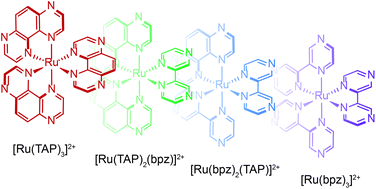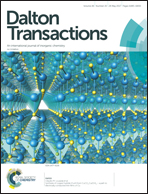Photochemistry of ruthenium(ii) complexes based on 1,4,5,8-tetraazaphenanthrene and 2,2′-bipyrazine: a comprehensive experimental and theoretical study†
Abstract
Polyazaaromatic ruthenium(II) complexes have been largely studied over the last decades, particularly in the scope of the biological applications, for the development of new diagnostic and phototherapeutic agents. In this context, Ru(II) complexes able to react with biomolecules upon excitation are of great interest. Photo-oxidizing Ru(II) complexes based on π-deficient ligands, such as bpz (2,2′-bypyrazine) and TAP (1,4,5,8-tetraazaphenathrene), were designed to allow a photo-induced electron transfer (PET) to take place in presence of biomolecules, thanks to their highly photo-oxidizing 3MLCT state. This PET can occur from either a guanine moiety (G) or a tryptophan residue (Trp) to the excited complex and can ultimately lead to the formation of a photoadduct, i.e. the formation of a covalent bond between the Ru(II) complex and the G or Trp moieties of a biomolecule. Here, we report the synthesis of two new photo-oxidizing Ru(II) complexes, [Ru(TAP)2bpz]2+ and [Ru(bpz)2TAP]2+, and the study of their photophysical and electrochemical properties. The influence of the structure of the ligand bpz/TAP on the photophysical and electrochemical properties of the four resulting complexes has been precisely determined thanks to the experimental and theoretical data obtained for to these new complexes.



 Please wait while we load your content...
Please wait while we load your content...